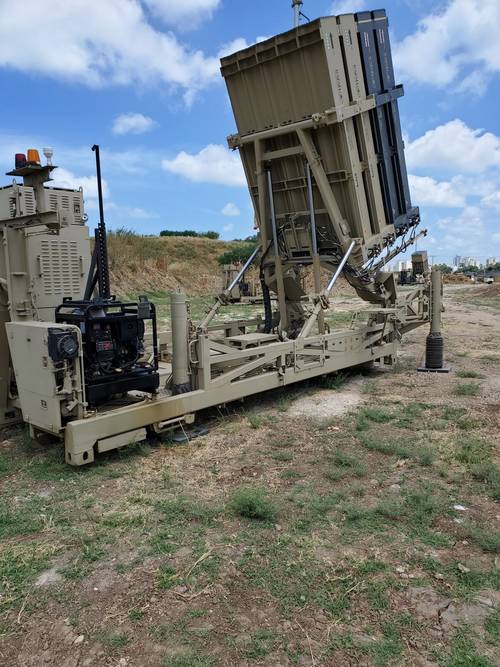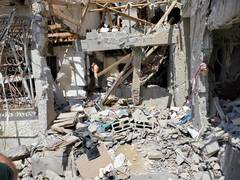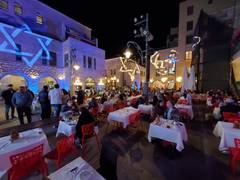- Worship
- Education
- Lifecycle
- Events & Programs
- About Us
- Join Us
- Donate
Rabbinic Solidarity Mission to Israel
Thursday, June 3, 2021
Today was the most challenging day of a challenging week. We visited Lod, the site of the most intense Jewish-Palestinian intra-civilian fighting during the recent conflict with Hamas. Lod is one of six “mixed cities” in Israel; it’s population is 70% Jewish and 30% Arab. It’s hard to say exactly what kicked off the recent fighting. There have been other conflicts with Hamas and other demonstrations in Jerusalem, but never such violence in Lod; but some say there were signs that should have been recognized. Either way, it was bad.
During the hour-long bus ride from Jerusalem, we were briefed by Anton Goodman about the situation in Lod. Anton works for the Abraham Initiatives in Lod, but many from B’nai Israel remember him as a previous shaliach to the Washington Jewish community. His understanding of the issues and ability to respond to questions (ours was a remarkably inquisitive bunch even for a group of rabbis!) is second to none. But even his thorough presentation could not prepare us. The mood among those who greeted us in Lod can only be described as utter shock. “I lived in this neighborhood for 15 years; I’ve always had friendly relations with my neighbors; and now I can’t even look them in the eyes.” We met separately with Jews and Arabs, each with their own understanding of the events. What they had in common, though, was a sense that something is seriously wrong. The dream of coexistence and commitment in Israel’s Declaration of Independence to “complete equality of social and political rights to all its inhabitants irrespective of religion, race or sex” might be compromised. There is work to be done before the Zionist project will be complete.
Our amazing group of rabbis traveled to the Shalom Hartman Institute in Jerusalem for an “Encounter” with Palestinians from East Jerusalem and processing time with Donniel Hartman. The questions and concerns were plentiful, as were the demonstrations of passion and love for Israel.
After a lovely concluding dinner in Abu Ghosh, it was off to the airport. I feel incredibly grateful for the opportunity to have been in Israel at this exact moment. It was just 52 hours, but what a trip. I can’t wait for the next opportunity to be back.
Wednesday, June 2, 2021
Today was a challenging day. Israel faces so many issues, and there are no easy solutions.
It was fortuitous that the day began with a presentation by Professor Reuven Hazan of the Political Science department at Hebrew University just moments after it was announced that the coalition partners reached an agreement to form a new government. Who better to explain the unprecedented nature of this agreement! For starters, this will be the first time an Arab party (the United Arab List, Ra’am) will be in the government; and it is not a liberal party. The United Arab List represents fundamentalist Muslims with sympathies for the Palestinian cause and even Hamas. So why would such a group join a right-wing Zionist government? To secure money Arab towns and cities badly need for education and infrastructure improvements. The coalition also includes Yamina, an extreme right party led by Naftali Bennet); Yisrael Beiteinu, an extreme right paper representing Russian immigrants and led by Avigdor Lieberman; New Hope, a breakaway party from Likud led by Gideon Saar; and Yesh Atid, a centrist party led by Yair Lapid. It is interesting that there were enough votes that the right-wing parties could have formed a government on their own without Yesh Atid or the Ra’am, by bringing in Likud and the Religious Zionist party. But they didn’t because that would have meant allowing Benjamin Netanyahu to remain prime minister. Yes, that’s correct, hatred of Benjamin Netanyahu is so high that these right-wing leaders would rather serve with an Arab party (and a centrist one) than allow Netanyahu to remain in his post. It is an exciting time for Israel, as new leadership is always exciting. But don’t expect stability; and don’t expect a peace breakthrough any time soon. No easy answers.
 We also visited an Iron Dome installation and the Israel Trauma Coalition in Ashkelon. There are currently 11 branches of the Trauma Coalition (5 in the “Gaza Envelope,” 4 in the West Bank, 1 serving Bedouin in the south, and 1 in Ashkelon); but, as you can imagine, the need is much greater. There are plans to establish 30 more centers in Israel. They preach an approach of resilience. It isn’t enough to respond to traumatic events; they also teach coping strategies and offer preparedness protocols to help people manage anxieties even before tragedy ensues. The events of the past two weeks in Israel’s “coexistence cities” are inducing more anxiety and post-trauma responses. More on that story tomorrow.
We also visited an Iron Dome installation and the Israel Trauma Coalition in Ashkelon. There are currently 11 branches of the Trauma Coalition (5 in the “Gaza Envelope,” 4 in the West Bank, 1 serving Bedouin in the south, and 1 in Ashkelon); but, as you can imagine, the need is much greater. There are plans to establish 30 more centers in Israel. They preach an approach of resilience. It isn’t enough to respond to traumatic events; they also teach coping strategies and offer preparedness protocols to help people manage anxieties even before tragedy ensues. The events of the past two weeks in Israel’s “coexistence cities” are inducing more anxiety and post-trauma responses. More on that story tomorrow.
While in Ashkelon, we visited the home of Pnina Makhluf. Her home sustained a direct hit by a Hamas rocket and was  completely destroyed. Pnina, though, wanted only to speak about the “three miracles”: she happened to have picked up her 2 ½ year-old grandson who was sleeping just moments before the sirens rang; she happened to get into the safe room just in time; her family members made it to safety as well. The next-door neighbor and her medical aid were not so lucky; the aid died, and the elderly neighbor lost both legs and is recovering in a hospital. The situation is not so simple. Here is a paraphrase of Pnina’s reaction to the current situation: If there was an ounce of logic, we could live together. We need to find a solution that we can all live with, beginning by acknowledging that we are all human beings. There are good Jews and bad Jews, good Arabs and bad Arabs, and the extremists are the minority. I want to just live together … but with logic. We aren’t going to go anywhere. And on coping with the post-traumatic stress of the past two weeks: I’m strong because I’m a mom. And if I break down, the whole family will break. My husband is already broken. … So I keep my pain until nighttime when they don’t need me anymore.
completely destroyed. Pnina, though, wanted only to speak about the “three miracles”: she happened to have picked up her 2 ½ year-old grandson who was sleeping just moments before the sirens rang; she happened to get into the safe room just in time; her family members made it to safety as well. The next-door neighbor and her medical aid were not so lucky; the aid died, and the elderly neighbor lost both legs and is recovering in a hospital. The situation is not so simple. Here is a paraphrase of Pnina’s reaction to the current situation: If there was an ounce of logic, we could live together. We need to find a solution that we can all live with, beginning by acknowledging that we are all human beings. There are good Jews and bad Jews, good Arabs and bad Arabs, and the extremists are the minority. I want to just live together … but with logic. We aren’t going to go anywhere. And on coping with the post-traumatic stress of the past two weeks: I’m strong because I’m a mom. And if I break down, the whole family will break. My husband is already broken. … So I keep my pain until nighttime when they don’t need me anymore.
After our two-hour ride back to Jerusalem, we enjoyed a most delightful dinner with former MK Gadeer Kamal-Mree. Ms. Kamal-Mree was the first Druze woman to serve as a news anchor on Israeli television; she was also the first Druze woman to serve in Knesset (as a member of the Blue and White party); and in a couple months, she will be coming to Washington (and living in our neighborhood and sending her two children to Farmland) as a shlicha to the Jewish Federation of Greater Washington. I’ve already suggested that one of her first presentations should be at B’nai Israel; watch for the invitation because you won’t want to miss her. Ms. Kamal-Mree began by describing her great pride in living in a community where more than 85% of the residents serve in the IDF. To put that number in perspective, about 75% of Jewish Israelis living in the West Bank currently serve in the IDF. She believes in Israel and would literally give her life to protect the Jewish state. But she ran for parliament out of a belief that Israel was not fulfilling its responsibilities towards its non-Jewish minority populations. The village in which she lives receives considerably less money for infrastructure and education than the nearby Jewish towns; and it isn’t right. Ms. Kamal-Mree expressed her worry that if changes are not made in villages like hers, more Druze might vote for Arab parties (i.e. separatist parties) in future elections. We asked Ms. Kamal-Mree who the Druze in her village would normally vote for if she had not been on the ballot (she estimates that her inclusion on the Blue and White list in 2018 brought 25,000 extra votes to that party; that’s a big number in tiny Israel). She told us that many of them vote for Shas, a right-wing ultra-Orthodox party that appeals because of its minority status.
delightful dinner with former MK Gadeer Kamal-Mree. Ms. Kamal-Mree was the first Druze woman to serve as a news anchor on Israeli television; she was also the first Druze woman to serve in Knesset (as a member of the Blue and White party); and in a couple months, she will be coming to Washington (and living in our neighborhood and sending her two children to Farmland) as a shlicha to the Jewish Federation of Greater Washington. I’ve already suggested that one of her first presentations should be at B’nai Israel; watch for the invitation because you won’t want to miss her. Ms. Kamal-Mree began by describing her great pride in living in a community where more than 85% of the residents serve in the IDF. To put that number in perspective, about 75% of Jewish Israelis living in the West Bank currently serve in the IDF. She believes in Israel and would literally give her life to protect the Jewish state. But she ran for parliament out of a belief that Israel was not fulfilling its responsibilities towards its non-Jewish minority populations. The village in which she lives receives considerably less money for infrastructure and education than the nearby Jewish towns; and it isn’t right. Ms. Kamal-Mree expressed her worry that if changes are not made in villages like hers, more Druze might vote for Arab parties (i.e. separatist parties) in future elections. We asked Ms. Kamal-Mree who the Druze in her village would normally vote for if she had not been on the ballot (she estimates that her inclusion on the Blue and White list in 2018 brought 25,000 extra votes to that party; that’s a big number in tiny Israel). She told us that many of them vote for Shas, a right-wing ultra-Orthodox party that appeals because of its minority status.
This is a complicated country; there are surprises and challenges every day. But it is a beautiful country; and it is our country; and it is our ONLY Jewish state. I feel so privileged to be here to share in the moment, if only for a short time. But I know I’ll be back!
Tuesday, June 1, 2021
I can’t believe I’m doing this. 6,000 miles each way to spend two-and-a-half days in Israel. I met up with our group—8 rabbis and the CEO of the Jewish Federation of Greater Washington—in the Newark Airport. Checking in was a little complicated because of extra forms and requirements from the Israeli Health Ministry, but our group had taken the necessary tests and made appropriate preparations in advance. The number one topic before boarding was … the process of reopening our synagogues and thinking forward to the High Holidays. Of course, that’s the side conversation; we know why we are going to Israel right now.
This is an important moment in history. We read all the articles about destruction in Gaza. Israel felt it had to respond to the rocket attacks; it had to destroy tunnels, reduce the rocket supply, and otherwise damage Hamas’s military infrastructure. The crisis was severe, but Hamas declared victory. Its goal is to destroy Israel; living another day is considered a win. The notion of “peace process” seems a long way off.
This recent round of fighting brought something else unprecedented in Israel. Mobs of Israeli Arabs and Israeli Jews rioted in some of Israel’s more mixed cities and towns, including Jaffa, Lod, Acre, and Haifa. The worry now is not just about the rockets, but that this prolonged situation could lead to a breakdown within Israeli society.
And yesterday it was reported that Israel is close to forming a new government. Naftali Bennet and Yair Lapid don’t share much besides their common desire to unseat Prime Minister Netanyahu. Bennet is a religious Zionist, former head of the Yesha Council (the umbrella organization of Israel’s settler movement), and a successful hi-tech entrepreneur. Lapid is a centrist media personality whose initial rise to prominence was based in a platform to scale back Orthodox control over marriage in Israel and require the ultra-Orthodox to serve in the military. They invited an Arab party, Ra’am, to gather the 61 seats necessary for the coalition. The agreement includes a rotation of prime minister, with Bennet serving for two years and Lapid finishing the term (if the government lasts that long).
These are the major issues as we begin our mission. Tonight we will have dinner with noted Israeli journalist Matti Friedman. His presentation will be great, but I’m looking forward to the questions; rabbis are never shy about asking questions. Wednesday’s itinerary takes us to Ashkelon and Sderot, cities on the edge, where we will explore the physical and psychological impact of the recent conflict and consider the possibilities moving forward. On Thursday we will be in Lod to explore a city of contrasts—rich and poor, Arab and Jewish, and a diversity of racial backgrounds. We will be meeting with Pnina Agenyau and Anton Goodman, two remarkable individuals who returned to Israel after their shlichut in Washington to work for non-profit social organizations. The packed itinerary also includes meetings with Palestinan journalists, leaders of the Muslim and Jewish communities in Lod, dinner with former MK Gadeer Kamal-Mree (the first Druze member of Knesset and incoming shlicha to Greater Washington) and several other notables.
I look forward to sharing more details, together with my own thoughts as I begin to process it all.
Shalom al Yisrael!
Fri, April 26 2024
18 Nisan 5784
Livestream
Shabbat Services
Friday at 6:15 PM
Saturday at 9:00 AM
the latest
announcements
Happy Passover from your B'nai Israel Family
We have programming and services throughout the holiday for all ages. Please join us.
Annual Meeting and Hineini Meeting "Thank You" Event on May 20
We are excited to gather our community. Please join for our Annual Meeting and Hineini "Thank You" Event.
Lessans Talmud Torah registration for 2024–2025 is open!
Registering early just got sweeter. Learn more about our program and registration raffle.
B'nai Israel Schilit Nursery School 2024-2025 Program Registration is now OPEN
Our award-winning school can't wait to meet your family. Very limited spaces remain. Learn more. View the beauty of our nursery school ART SHOW.
B'nai Israel First Synagogue in North America to Install RightHear, supporting those who are blind or low vision.
Read our press release here.
NEW Resource: Fighting Antisemitism
Raise Awareness, Educate, and Act to stop antisemitism. Learn more.
Our 2023-2024 Hineini Annual Campaign is Under Way
B'nai Israel is "Here for YOU". Support us today.
Join Our Shabbat Morning Livestream
Click here to access.
Explore Our Exciting Adult Education Offerings
Learn more here.
weekday services
Sunday | 9:00 AM & 8:00 PM
Monday–Thursday | 7:15 AM & 8:00 PM
Friday | 7:15 AM
*Service times vary on holidays.
Click here for access information.
shabbat services
Friday | 6:15 PM (7:00 PM during Summer)
Saturday | 9:00 AM & 12:30 PM (Minha)
Click here for access information.
inclement weather policy
Click here for information.




